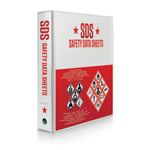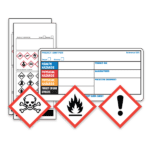
Spring Clean Your Digital HazMat Files
As spring rolls in, it’s the perfect time to refresh and reorganize—not just your physical space, but also your digital one. In the world of hazardous materials (HAZMAT) and dangerous goods (DG) management, digital hoarding can lead to inefficiencies, compliance risks, and even safety issues. Failing to regularly clean up your digital files can result in outdated or conflicting information being used, creating confusion during shipments, inspections, or audits. Here’s why and how you should prioritize a digital cleanup this spring.
The Risks of Digital Document Hoarding in HazMat Management
In industries dealing with hazardous materials, digital documentation is essential for maintaining regulatory compliance. However, hoarding outdated or redundant files can have serious consequences:
- Conflicting Information: Retaining multiple versions of safety data sheets (SDS), shipping declarations, or emergency response plans increases the risk of using incorrect or expired documents. This can lead to non-compliance with regulations such as 49CFR, Transportation of Dangerous Goods (TDG), IATA, or IMDG.
- Regulatory Inconsistencies: Digital clutter often results in conflicting labeling, packaging instructions, or classification details. Using old templates or forms could lead to improper documentation, which may result in rejected shipments, fines, or delays.
- Reduced Efficiency: Sifting through outdated or disorganized folders during audits or incidents slows down response times. In emergencies, quick access to the correct documentation is critical for effective and safe action.
- Data Security Risks: Hoarding sensitive customer information, shipping records, and confidential compliance reports increases the risk of data breaches. Outdated files that no longer serve a purpose should be removed to reduce exposure.
Regulatory Document Retention Requirements
When conducting a digital cleanup, it’s essential to remember that both the USA and Canada have strict regulations on the retention of HazMat and DG-related documents:
Shipping Documents:
- Under U.S. 49 CFR § 172.201(e), shippers and carriers must keep shipping papers for two years for hazardous materials.
- Under Canadian TDG regulations (TDGR 3.11), shipping documents must be retained for two years after the shipment date.
Classification documents:
- Canada (TDGR): Manufacturers and importers must retain proof of classification for five years under the TDGR and since SDS’s are such documents keep this in mind.
Training Records:
- In the U.S., they must be kept for three years from the date of the last training (49 CFR § 172.704(d)).
- Under TDG regulations, training certificates must be retained for two years after their expiry date.
When cleaning up your digital space, ensure that you are not deleting records that are legally required to be retained. Use clearly labeled archive folders for retention-compliant storage.
Signs It’s Time for a Digital Clean-Up
- If you work with HazMat shipping, classification, or compliance, here are some indicators that your digital space needs attention:
- You frequently struggle to find the latest version of SDS, training certificates, or shipping templates.
- You have multiple versions of the same document saved under different names, making it unclear which is current.
- Your compliance team regularly updates regulations, but old, non-compliant files still circulate internally.
- Your shared drives contain redundant folders from years past, causing confusion and inefficiency.
Spring Cleaning Tips for HAZMAT and DG Professionals
- To ensure your digital space supports safe and compliant HazMat and DG management, follow these practical tips:
- Organize by Date and Version: Keep only the latest, approved versions of SDS, shipping declarations, and training records. Clearly label files with revision dates to avoid confusion.
- Archive or Delete Old Records: While regulatory retention periods require keeping certain records, remove outdated or redundant files. Archive older documents in clearly labeled folders with expiration or review dates.
- Create Clear Naming Conventions: Use consistent, standardized file names (e.g., SDS_Acetone_v2025) to make it easier to identify current documents.
- Review and Streamline Compliance Folders: Perform a systematic review of folders containing regulatory information, removing duplicates and consolidating scattered files.
- Backup and Secure Important Files: Once cleaned, back up critical compliance documents to a secure location, such as an encrypted server or cloud storage, with proper access controls.
- Train Your Team on Digital Hygiene: Educate employees on the importance of maintaining an organized digital space, especially when dealing with regulatory documents.
The Benefits of a Clean Digital Space
A well-organized digital environment improves efficiency, reduces compliance risks, and enhances safety. With accurate and easily accessible documentation, you’ll be better prepared for audits, inspections, and day-to-day shipping operations. Spring is the perfect time to refresh your digital filing system and build a stronger foundation for safe and compliant dangerous goods management.
Tip: As you tidy up your digital space, create a retention compliance folder for shipping documents, SDSs, and training records. This ensures you meet the legal retention periods in both the U.S. and Canada, while keeping your digital workspace organized and efficient.
By tackling digital hoarding this spring, you’ll boost productivity, reduce regulatory headaches, and promote safer handling of dangerous goods all year long.
ICC is passionate about keeping us all safe when handling, storing, manufacturing, or transporting dangerous goods. Our team can help your business stay compliant and informed through our resources and products. Contact us to learn more about the ICC difference.
Stay up to date and sign up for our newsletter!
We have all the products, services and training you need to ensure your staff is properly trained and informed.
 SDS Services SDS Services |
 GHS/OSHA/WHMIS Labels GHS/OSHA/WHMIS Labels |
 OSHA/WHMIS/GHS OSHA/WHMIS/GHSTraining Courses |





